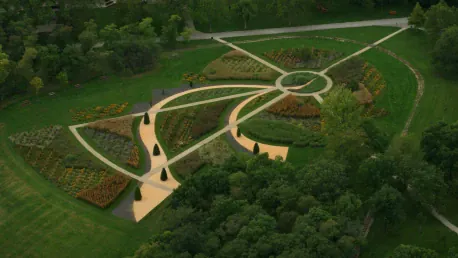You are considering a complete redesign of your backyard or front yard landscape or would like to make some upgrades and changes. It’s essential to take note of significant factors that influence an effective landscape design. Do not wait until summer to plan your landscape design; starting the planning process now can help you avoid the summer rush. Many people mistakenly begin this journey by heading straight to the garden center, purchasing plants and decor without any architectural planning beforehand. Beautiful plants, flowers, and shrubs can be very tempting, particularly for those executing the project on their own without any professional assistance or general knowledge in landscaping, often resulting in the wrong plant choices for the spring and summer seasons. These five steps will guide you in creating a comprehensive plan and set you on the path to designing a beautiful landscape haven.
1. Soil & Weather Conditions
When planning your landscape, it is paramount to consider the regional weather, the terrain of your yard, whether front or back, and the soil type. Understanding specific land conditions may create a microclimate based on the duration and exposure to sunlight the land receives. There are four recognized categories of microclimates to be aware of: dry soil with lots of sunlight is excellent for drought-resistant plants; moist soil with plenty of sunlight is perfect for a water garden; dry soil in shaded areas is ideal for cool-weather plants that wilt in the sun; and moist soil in deep shade is suitable for a woodland garden. These microclimates play a considerable role in plant selection, so it is crucial to evaluate them carefully.
Equally important is noting the terrain of the land and how water drains through it. The primary objective of a robust and healthy landscape design is to ensure that water movement is directed away from the building towards other areas of the yard. Proper drainage not only preserves the integrity of the house but also supports the longevity of the landscape elements themselves. Incorporating these environmental factors into your landscape design approach is fundamental for a flourishing and sustainable outdoor space.
2. How Much Are You Willing to Spend?
Whether you plan to maintain your yard yourself or employ someone for the task, understanding your budget and upkeep preferences is vital. Be realistic in setting expectations and allocating your budget. Key questions to consider include the time commitment you are willing to invest in your landscape, the cost per hour or per service if hiring a professional, and an accurate assessment of how much financial investment is needed to achieve your landscape vision. Answering these questions can help align your dreams with practical financial considerations, ensuring you obtain the landscape you envision.
It’s advisable to seek assistance from a landscape design expert such as The Beaudry Group if needed. They can provide valuable insights and professional evaluations that align with your preferences and budget constraints, helping you achieve a well-balanced and stunning landscape design. Discerning the intersection between personal effort, professional assistance, and financial investment is fundamental to attaining your dream landscape.
3. What Style Are You Aiming For?
Choosing the desired theme for your landscape personalizes the space and guides in selecting plants and materials. Themes can consist of consistent shapes and forms throughout the landscape or embody various styles, such as a relaxation garden or an oriental garden. Start by observing the architecture of your home to complement its lines and style within your yard. Considering your yard as an extension of your home can present a unified theme that enhances overall aesthetics and cohesion.
Personalized themes serve as a roadmap for placing and selecting plants, decorations, hardscapes, and other structures. Some questions to help define your theme include your preference for geometric structures and hardscapes, natural elements with softer visuals, or diverse color combinations. Addressing these questions will lead to a tailored theme that cohesively blends with your home and expresses your personality.
4. Design and Connect Spaces
Your landscape space offers more than a place for retreat, hosting, or relaxation; it extends your home’s living space. Viewing it as an equally useful area like your bedroom, kitchen, or family room means selecting elements and materials that enhance its livability regardless of weather conditions. Some people have discovered ways to make their backyard landscapes as functional in the winter as in the summer. A backyard can serve as a makeshift office, dining area, and space for relaxing naps and reading – adaptable to any weather condition.
Additionally, consider how to connect and transition between spaces within your yard. Creating openings and pathways that inspire exploration encourages movement and interaction throughout the landscape. This interconnection fosters an inviting atmosphere and enhances the overall functionality and aesthetic appeal of the outdoor space. Treat the landscape as an integral part of your living area to achieve a seamless and vibrant home extension.
5. Pay Attention to the Details
When planning your landscape, it’s crucial to consider regional weather, terrain, and soil type. The conditions of your yard can create a microclimate based on the sun exposure it receives. There are four types of microclimates: dry soil with lots of sunlight is great for drought-resistant plants; moist soil with ample sunlight is ideal for a water garden; dry soil in shady spots suits cool-weather plants that can’t handle intense sun; and moist soil in deep shade is good for a woodland garden. These microclimates significantly influence plant selection, so evaluating them is essential.
Equally important is recognizing the terrain and managing how water drains through your yard. A key goal of effective landscape design is to direct water away from the house and towards other parts of the yard. Proper drainage helps protect the house and ensures the longevity of landscape features. Considering these environmental factors in your landscape design is crucial for creating a thriving, sustainable outdoor space. Integrating these natural elements into your plan can lead to a beautiful and resilient landscape.









